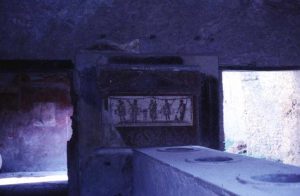Most of us know the tragic story of the ancient town of Pompeii, located 150 miles south of Rome and 16 miles from Naples. One of the many good histories about Pompeii and the volcanic eruption that buried it in 79 CE, killing 2,000 people, can be found on the History Channel website.
Fewer of us know much about a female resident of the city who was prominent in several ways, who contributed funds for a building, and a statue of whom has survived. The woman was Eumachia, and her story illustrates the presence, role and influence of high-status women in the years around the time of St. Paul and other early Christians. It also shows the intimate relationship in antiquity between wealth, status, business, politics and religion.
Eumachia, Priestess and Patron
According to the archaeological evidence, Eumachia was the daughter of a man named Lucius. His was a prominent Pompeiian family that owned vineyards and brickworks, and the men of the family were active in civic affairs. Eumachia’s building “reveals the wealth and power of the Eumachii, as well as their pride… [T]hey dared to erect in Pompeii a small-scale imitation of the imperial forum.” (Etienne, 87-88)
The building – possibly a wool market – measured 200 by 130 feet and was located on the corner of the Via dell’Abbondanza in the southeastern corner of the forum. (Etienne, 86; Piemme and Enrika D’Orta, 13) An inscription over one of its two entrances reads, “Eumachia, daughter of Lucius, priestess of the people, in her own name and in that of her son Numistrius Fronto, built this entrance hall, a cryptoporticus and a portico with her own money, and dedicated them to the honor of Augustan Concord and Piety.” (Etienne, 86) An alternate translation of the first phrase reads “Eumachia daughter of Lucius public priestess [of Venus].” (D’Orta and D’Orta, 13)
The building was quite impressive, boasting a two-story colonnade and lavish decoration, and would have displayed statues of the emperor Tiberius and Drusus; (Etienne, 86-87) Tiberius and Drusus were both sons of Livia (see below), but Drusus died in 9 BCE, before he had a chance to become emperor. The Eumachia building had been damaged during the earthquake of 62 and rebuilt during the reign of Tiberius (14-37 CE). (D’Orta and D’Orta, 13)
A marble statue to Eumachia herself, now in the National Archaeological Museum of Naples, was also discovered in the excavation of the building. The statue was dedicated to her by the guild of the fullers (wool weavers and washers), attesting to her generosity to these workers. (D’Orta and D’Orta, 13) The paint remaining on the well-preserved statue shows, intriguingly, that Eumachia may have been a redhead. (Brilliant, 91) The statue, along with several architectural features, is the reason archaeologists conjecture that the building was used primarily as a wool market. (Grether, 249-50)
Cults and Priestesses
There are many take-aways from this basic information.
First, Eumachia was not only a daughter but also a wife (although we know little about her husband) and the mother of at least one son, Numistrius Fronto. She had control of at least some of her own money, given the features of the building for which she paid.
Second, she was held in high regard by the wool weavers and washers, who raised enough funds to have a statue built in her honor.
Third, Eumachia was a priestess of the emperor cult. The statue of Concordia Augusta holding a cornucopia is a personification of Livia – wife of Augustus and mother of Tiberius – and represents “the emotional union between her and her son Tiberius, after her illness of 22.” Livia, who was deified by Emperor Claudius in 42 CE, was renowned in antiquity as “mother” and was a generous benefactor. (Barrett, Livia, 108ff and passim) The statue in Eumachia’s building can be seen as her statement of loyalty to the emperor and Livia and of Eumachia’s modeling her life after the tight mother-son relationship between Livia and Tiberius. (Etienne, 88)
In addition, Eumachia may have “celebrated the cult of this Livia-Ceres figure” (Etienne, 88), Ceres being the Latin name of the goddess Demeter. The priestly office of this cult was always held by women (although early on, there may have been male priests).
Municipal priests and priestesses were elected by the city’s legislative body. Although they were not paid for their service, sometimes they were “promised certain largesses, such as spectacles and games.” These elected officials donated beautiful buildings and statues to their cities, demonstrating their wealth and influence. (Grether, 249-50)
In Portrait of a Priestess, Joan Breton Connelly presents extensive archaeological and literary evidence for a high level of female involvement and leadership in ancient cults for centuries. The evidence clearly shows the following:
- Female cult agents were public office holders “with a much broader civic engagement than was previously recognized.” (Connelly, 3)
- The religious “positions of leadership held by priestly women were primary, not peripheral to the centers of power and influence.” (Connelly, 5)
- The religious and the secular were intimately connected for the ancients, as were the public and the private. Temple rituals mirrored household rituals, which involved women to a high degree. Since in Attica alone during the classical era there were approximately 2,000 cults in operation and 170 festival days a year, the “organization and performance of cult activities was a widely shared experience within the citizen body,” making women’s involvement vitally important. (Connelly, 3-10)
- Priesthood was more often than not temporary, rather than lifelong, and offered the opportunity to participate in public life.
 The evidence generally reflects priestesses from elite families; “in the case of Greek priesthoods, pedigree, wealth, or both were basic requirements for attaining office.” Therefore, while slave women may not usually be represented in the ranks of priestesses, there is overwhelming evidence for broader participation of women in public life, their influence, their prestige and their visibility than has been previously acknowledged. “Knowledge of ritual practice, local myths, and ancestral traditions invested priestly women with a cultural capital that made them invaluable to their communities… [T]he accumulated prestige of priestesses, in leading public processions, overseeing polis festivals, sitting in reserved seats at the theater, and having their images erected in sanctuaries, guaranteed them a symbolic capital that must not be underestimated in a world in which status carried long-lasting power.” (Connelly, 24)
The evidence generally reflects priestesses from elite families; “in the case of Greek priesthoods, pedigree, wealth, or both were basic requirements for attaining office.” Therefore, while slave women may not usually be represented in the ranks of priestesses, there is overwhelming evidence for broader participation of women in public life, their influence, their prestige and their visibility than has been previously acknowledged. “Knowledge of ritual practice, local myths, and ancestral traditions invested priestly women with a cultural capital that made them invaluable to their communities… [T]he accumulated prestige of priestesses, in leading public processions, overseeing polis festivals, sitting in reserved seats at the theater, and having their images erected in sanctuaries, guaranteed them a symbolic capital that must not be underestimated in a world in which status carried long-lasting power.” (Connelly, 24)
For all intents and purposes, the religious sphere was “the only appropriate one for a woman’s philanthropy.” (Bremen, 26-27) But despite this seeming absence of autonomy and the fact that the majority of strictly political offices were off-limits to women, “many of the offices . . . accessible to women were, in fact, among the most prestigious in Greek cities. . . It is not the case, then, that women were fobbed off with insignificant, empty, ceremonial jobs: ceremonial many may well have been, but they were prestigious first and foremost.” (Bremen, 56-57)
Significance
The case of Eumachia at Pompeii is a microcosm of practices that took place across the Roman Empire, a time when Christianity was developing. Evidence for priestesses, female benefactors and influential high-status women has been found in archaeological excavations throughout the Mediterranean. Jews and Christians, such as those we know from the New Testament and other early Christian literature, would have known about these women – and perhaps even have been such women prior to conversion.
The building of Eumachia is a testament to the existence of women with resources – almost always due to the wealth of their natal families – who undertake projects on behalf of their communities. If the building is indeed a wool market, it also seems to be a testament to her popularity among those workers.
From this and other evidence from cities throughout the Mediterranean, we can see that women played important roles in religious groups at both participant and leadership levels in the first century CE, and religion was intimately related to civic life. Women from elite, wealthy families used their wealth in service to their communities through the building of monuments, structures, statues, and worship spaces to garner favor with other elite families in the community, to act as patrons, and to demonstrate the carrying out of the duties inherent in their stations in life. The world of early Christianity was, in short, a world of women and goddesses, not just men named Jesus, Paul, Matthew, Mark, Luke and John.
Resources
Abrahamsen, Valerie. “Priestesses and Other Female Cult Leaders at Philippi in the Early Christian Era,” in Joseph A. Marchal, ed., The People beside Paul: The Philippian Assembly and History from Below, 25-62. Atlanta, GA: SBL Press, 2015.
Barrett, Anthony A. Livia: First Lady of Imperial Rome. New Haven and London: Yale University Press, 2002.
Bremen, Riet van. The Limits of Participation: Women and civic life in the Greek East in the Hellenistic and Roman periods. Amsterdam: J.C. Gieben, Publishers, 1996.
Brilliant, Richard. Pompeii AD 79: The Treasure of Rediscovery. New York: Clarkson N. Potter, Inc., Publishers, 1979.
Connelly, Joan Breton. Portrait of a Priestess: Women and Ritual in Ancient Greece. Princeton and Oxford: Princeton University Press, 2007.
D’Orta, Piemme and Enrika. Together in Pompeii. Pompeii: Falanga Edizioni Pompeiane, 1985.
Etienne, Robert. Pompeii: The Day a City Died, Discoveries Series. New York: Harry N. Abrams, Inc., Publishers, 1992.
Grether, Gertrude. “Livia and the Roman Imperial Cult,” American Journal of Philology, Vol. LXVII (1946) 222-52.


